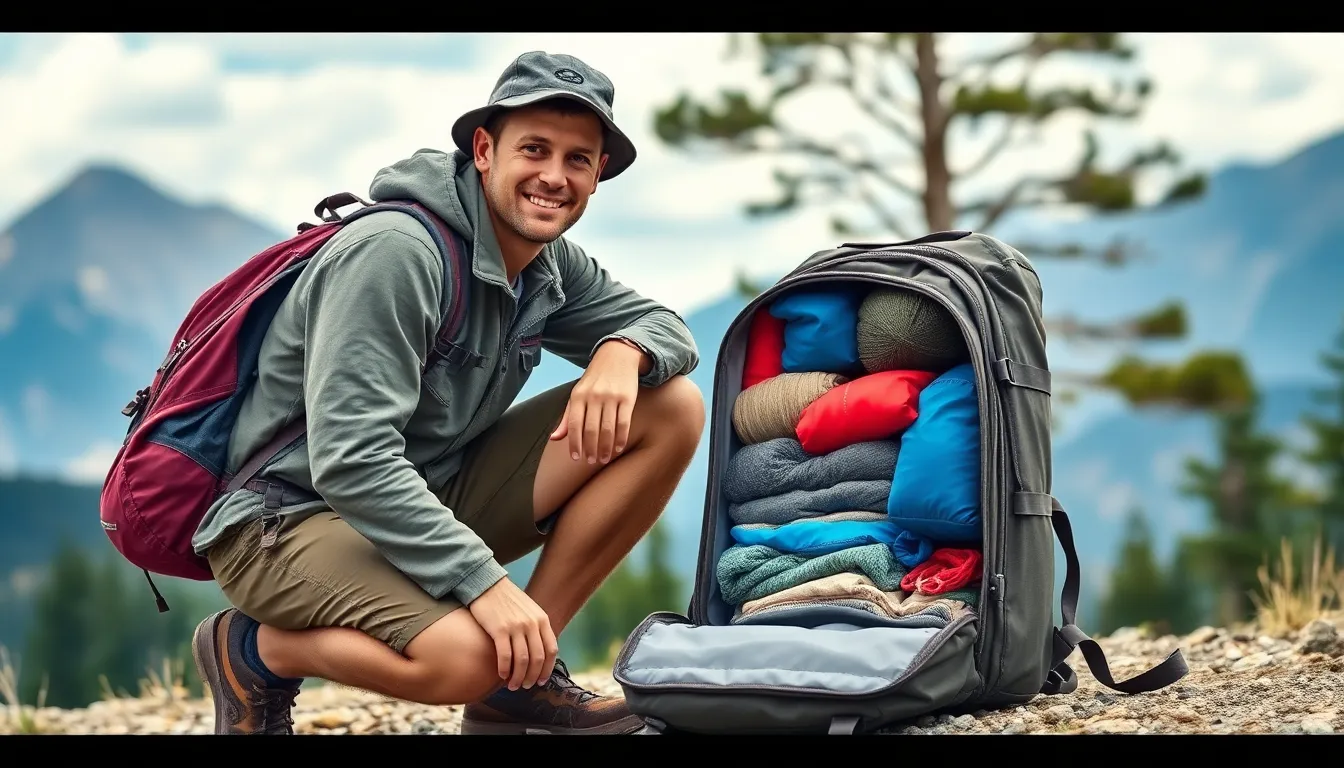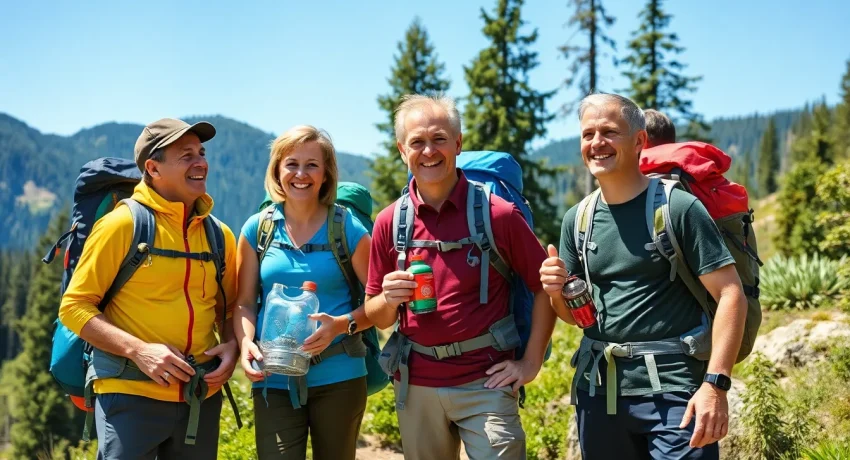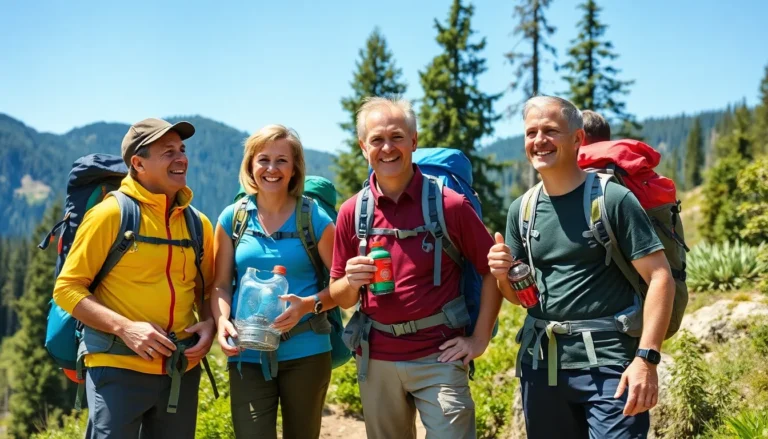Table of Contents
ToggleBackpacking can be a thrilling adventure, but it often comes with its fair share of challenges. Imagine hiking up a steep trail, only to realize you packed three pairs of socks but forgot the snacks. Oops! Luckily, with a few clever backpacking hacks, even the most novice adventurer can turn potential mishaps into memorable moments.
Top Backpacking Hacks for Every Adventurer
Keeping essentials organized improves the overall backpacking experience. Use packing cubes to separate clothing types for easy access to layers, socks, and undergarments. Roll clothes instead of folding them to maximize space and reduce wrinkles.
Optimize meal preparation by utilizing lightweight, dehydrated meals. These options require minimal cooking, making meal times efficient and hassle-free. Add instant soups or oatmeal for quick, nutritious snacks on the go.
Utilizing duct tape provides a simple solution for various gear issues. Wrapping some around a water bottle saves space while ensuring easy access when repairs are needed. Include a multi-tool to manage any unexpected equipment problems during the journey.
For hydration, consider using a hydration bladder instead of traditional water bottles. This method ensures easy sipping and reduces the need for frequent stops. Incorporate electrolyte tablets in your water to maintain energy and hydration levels throughout long hikes.
Protect electronics with resealable plastic bags. These bags guard against moisture and dirt, keeping devices safe for navigation and communication. Store a small power bank in your pack to ensure devices remain charged.
Carrying a lightweight, portable stove enhances cooking flexibility. Compact models burn fuel efficiently and contribute to an enjoyable meal experience. Choose reusable utensils to minimize waste while enjoying your favorite meals outdoors.
Lastly, consider packing a small first aid kit. Including basics, like adhesive bandages and antiseptic wipes, ensures preparedness for minor injuries. Having a headlamp on hand provides necessary light for nighttime tasks or emergency situations.
Packing Tips and Tricks

Effective packing transforms a backpacking trip. Employing efficient techniques can save space and minimize weight.
Efficient Packing Techniques
Utilize packing cubes for organized compartments within the backpack. Rolling clothes increases packing efficiency, reducing wrinkles and maximizing space. Prioritize heavier items at the bottom of the pack for optimal weight distribution. Consider using compression bags for bulky clothing, allowing for more room. Group similar items together, making it easier to access essentials when needed. Finally, ensure critical gear is easily reachable, such as first aid kits or snacks.
Essential Gear for Light Packing
Select a lightweight sleeping bag for comfortable rest without excess weight. Include a compact tent that balances durability with portability. Choose a multi-functional tool, which replaces several items, minimizing clutter. Opt for dehydrated meals that are easy to prepare and lightweight to carry. Pack a portable stove, which offers cooking flexibility without compromising space. Invest in reusable utensils that reduce waste and fit nicely into small containers. Include a hydration bladder for convenient access to water throughout the journey.
Cooking Hacks on the Trail
Cooking on the trail can be simple and enjoyable. With the right hacks, backpackers can prepare satisfying meals with minimal effort.
Quick and Easy Meal Ideas
Opt for instant oatmeal for breakfast; it’s nutritious and requires only hot water. For lunch, try pita bread filled with hummus and pre-cut veggies. Pack pre-cooked rice or quinoa packets; they heat up quickly and serve as great bases for different meals. Add packets of tuna or chicken for protein. Consider energy bars for easy snacks between meals; they offer convenience and fuel. Instant soups also provide warmth and hydration. These options save time while ensuring balanced nutrition throughout the hike.
Portable Cooking Equipment
Invest in a lightweight portable stove; it offers convenience and efficiency for outdoor cooking. Choose a compact cooking pot that nestles within your gear to save space. Select a multi-fuel stove; this option allows flexibility with fuel types. Carry a collapsible silicone cooking utensil set; it’s easy to pack and reduces bulk. Utilize a small, portable cutting board for meal prep, ensuring quick and safe food preparation. Additionally, include a lightweight coffee filter or mesh bag to brew fresh coffee. Each of these tools enhances the cooking experience on the trail.
Navigation and Safety Hacks
Backpacking demands attention to navigation and safety, ensuring a secure adventure without losing the joy of exploration.
Utilizing Technology and Apps
Smartphones enhance navigation during backpacking trips. Offline maps, such as Maps.me or Gaia GPS, provide essential directions without data usage. GPS devices also serve as reliable alternatives in remote areas. Additionally, using apps like AllTrails assists in tracking routes, offering detailed trail information and user reviews. Some platforms even allow users to save their locations, making it easier to retrace steps if needed. Setting up emergency contact features on devices fosters peace of mind, enabling quick communication in case of unforeseen events. Embracing technology can elevate safety and improve the overall hiking experience.
First Aid and Emergency Preparedness
Carrying a well-stocked first aid kit proves crucial during backpacking. Essential items include adhesive bandages, antiseptic wipes, and gauze pads. Equipping kits with allergy medications and blister treatments offers vital support for common hiking ailments. Preparing for emergencies includes carrying a whistle, which serves as a signaling device in unexpected situations. Moreover, knowing basic first aid techniques empowers hikers to handle minor injuries effectively. Planning an emergency evacuation route and sharing trip details with someone not on the hike promotes safety. Being prepared ensures that backpackers can confidently face challenges along the trail.
Eco-Friendly Backpacking Hacks
Backpacking can be environmentally friendly with a few smart practices. Embracing sustainable strategies protects nature while making outdoor adventures enjoyable.
Leave No Trace Principles
Following Leave No Trace principles ensures minimal impact on ecosystems. Backpackers should plan trips carefully, choosing established trails and campsites to avoid disturbing wildlife. Disposing of waste properly is crucial; packing out trash equals leaving no trace behind. Ignoring this step can harm wildlife and plants. Remaining on designated paths preserves fragile landscapes and respects fellow hikers. Minimizing campfire impact involves using camp stoves instead, reserving natural resources and reducing fire risk. Practicing these steps helps maintain the beauty of nature for future generations.
Sustainable Gear Choices
Choosing sustainable gear can significantly reduce one’s environmental footprint. Opting for items made from recycled materials promotes resource conservation. Investing in durable gear saves money over time while minimizing waste. Brands that prioritize sustainability often use eco-friendly practices, further supporting the environment. Lightweight gear aids in efficient packing, reducing energy consumption during transportation. Additionally, using second-hand items helps extend the lifecycle of products while reducing demand for new resources. Prioritizing these sustainable choices enhances the backpacking experience while being kind to the planet.
Backpacking can be an incredible adventure filled with unforgettable experiences. By implementing these hacks, backpackers can enhance their journeys while avoiding common pitfalls. From clever packing techniques to eco-friendly practices, these tips empower adventurers to travel smarter and lighter.
Staying organized with packing cubes and choosing lightweight gear can make all the difference on the trail. Prioritizing safety and navigation ensures peace of mind, allowing hikers to focus on the beauty around them.
Embracing sustainability not only protects the environment but also enriches the outdoor experience. With these strategies in hand, anyone can embark on a successful backpacking trip, ready to explore the great outdoors with confidence.




